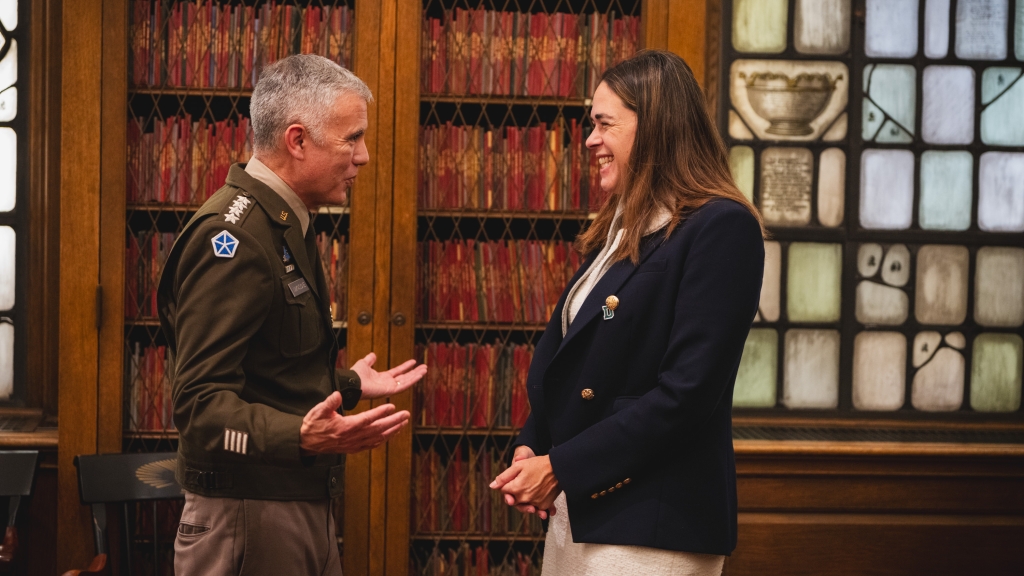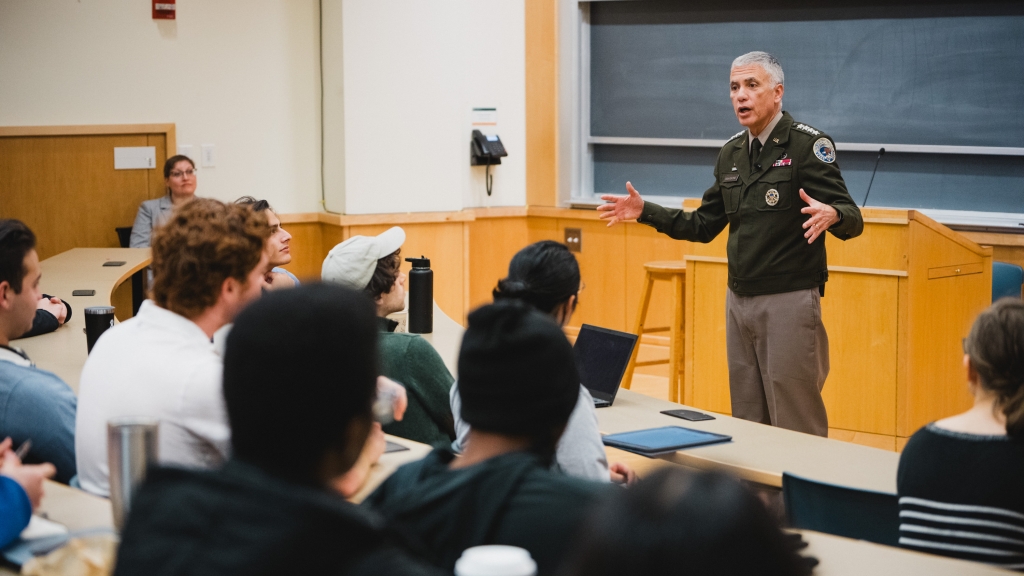As foreign military and intelligence threats to the United States continue to evolve, the role of both the National Security Agency and U.S. Cyber Command is to "balance national security and civil liberties and privacy," Gen. Paul Nakasone, who has led both agencies since 2018, said during a visit to Dartmouth on Wednesday.
Balancing security and civil liberties is an "and, not an or," said Nakasone. "An agency with significant surveillance powers should be overseen—and we are. We publish oversight findings. When we make a mistake, we admit that mistake and we correct that mistake and make sure folks know about it."
A four-star general, General Nakasone participated in a fireside chat led by Provost David Kotz '86, the Pat and John Rosenwald Professor in the Department of Computer Science. More than 50 students attended. He then spoke to a computer science class led by Adjunct Professor Charles Palmer in Spanos Auditorium in the Cummings Building.
During his visit, Nakasone also met with President Sian Leah Beilock, with ROTC at Dartmouth staff and cadets, and had lunch with John Sloan Dickey Center for International Understanding War and Peace fellows and government postdoctoral students.
Nakasone led discussion on such issues as election integrity, cyber warfare, the potential advantages and pitfalls of artificial intelligence, and what he views as the nonpartisan nature of the job, regardless of who is president.
"I'm a military officer who swore an oath to the Constitution," he said.

NSA director Paul Nakasone, an Army general, talks with ROTC cadets, from right, Brian Zheng '24, Nate Attia, '27, Cooper Hyldahl '26, and Elias Moyse '27. (Photo By Robert Gill)
A Minnesota native, Nakasone graduated from Saint John's University in Collegeville, Minn., where he received a commission through the Reserve Officers' Training Corps. He has held a variety of command and staff positions in the U.S., South Korea, Iraq, and Afghanistan.
The NSA, which was founded in 1952 and is part of the Department of Defense, specializes in signals intelligence. It "makes code and breaks code," Nakasone said, and tracks foreign adversaries, whether state actors or terrorists, through communications systems, radar, and weapons systems, according to the NSA website.
U.S. Cyber Command, created in 2009, operates "in one domain, and that is cyber space," Nakasone said. It is the Pentagon’s warfighting force in cyberspace, supporting joint force commanders and defending the nation from significant cyberattacks.
Both entities are responsible for defending the integrity and security of national elections from disruptive foreign actors such as Russia, North Korea, and China. When the NSA and U.S. Cyber Command examined what happened in the months prior to the 2016 presidential election, with evidence of Russian interference and a widespread disinformation campaign, the next questions were these:
What would the Russians do in subsequent national elections, and how would national security respond? Would the NSA and U.S. Cyber Command be reactive, or pro-active? After assuming his job, Nakasone said, he noticed that there was a gap in how the agencies were responding to threats. If some staff were reporting, and others were doing the planning, "who's doing the doing?" was his question.
In the 5½ years Nakasone has headed both agencies, the "what"—signals intelligence and cyber security—has not changed that much, he said. But the "how" and the "who" have.
Partnerships, Nakasone said, have become a critical component in safeguarding the nation and its allies. Outside the high security restricted areas, in the NSA’s unclassified Cybersecurity Collaboration Center, experts from hundreds of private American companies that make up the defense industrial base work side-by-side with the government to identify and neutralize cyber threats.
There is a recognition that no one entity, organization, or country can wrap its arms around all the varying threats in cyberspace. "From one partner in 2019 we've gone to more than 500 partners today," he said. Being able to work with the private sector is critical, he said. In 2019, for example, an NSA researcher found a vulnerability in Microsoft's Windows 10 that could be exploited by foreign actors. "We raced to get the patch up," Nakasone said.
He then asked government lawyers whether the NSA could take public credit for spotting the hole. The lawyers said the agency had never done that before. In early 2020, Nakasone said, he made the determination that the NSA should take credit.
"NSA workers need to see that, as well as the nation."

NSA director Paul Nakasone, an Army general, meets with President Sian Leah Beilock in the Treasure Room of Baker Library. (Photo By Robert Gill)
In a similar vein of public transparency, Nakasone pointed to the decision by the Biden administration in the fall of 2021 and early winter of 2022 to release to the media "the most sensitive information" warning of an impending invasion of Ukraine by Russia.
"We're going to take what we know about the Russians and we're going to be able to share it with our partners and the world. That preemptive release of information was powerful," he said.
During two Q&A sessions, Nakasone also answered questions about the difference between foreign threats and what he termed "insider threats" within the country. He spoke about monitoring people who work for the government, which is to be expected, versus the surveillance of ordinary citizens, which is not.
Students asked him about distinguishing fact from fiction, given the proliferation of misinformation and disinformation on social media, specifically citing the Chinese-owned TikTok, one of the most popular platforms in the world.
"TikTok is a loaded gun at our nation's head," he said, when you look at the high percentage of Americans who rely on TikTok as a primary news source. "People don't necessarily read the news, they react to the news. … We have to be conscious of who's creating the message."
Nakasone, who plans to step down from his government posts once a successor is confirmed by the U.S. Senate, also extolled the virtues of public service and encouraged students to look at the NSA and U.S. Cyber Command for possible careers. The agencies are looking for "a workforce that reflects the demographics of our nation," he said.
Nakasone noted that Dartmouth has a rich history of public service, citing such graduates as Robert Reich, the secretary of labor in the Clinton administration, and several members of the U.S. Senate. The NSA has also sponsored research at Dartmouth, he said.
The key, he told students, is to "find your passion. Once you find your passion, really, really push into it."
"The ethos of public service is really very powerful," Nakasone added.
As a result of Nakasone's visit, Yasmeen Hussein '26, a computer science major, wants to explore cybersecurity. She would also like to see more women in the field. "I knew he would have great insights," she said.
